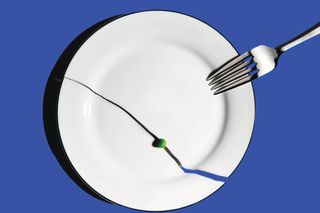
Anorexia Is the Most Deadly Eating Disorder; Here’s What You Need To Know About It
Though relapse is common, anorexia can be fully cured via treatment and support systems.

“Are we threatened by flesh or its opposite? Though the temporarily thin find it easy to preach against the fat, we are much more interested in anorexia than in obesity. We all understand self-indulgence but are afraid that self-denial might be beyond us,” writes Hilary Mantel for The Guardian.
Though eating disorders predate modern diet culture, fearing and shunning food to the point of illness is intrinsically tied to beauty standards, the diet industry, and wellness culture. Of these illnesses, the most well-known is anorexia nervosa. Well-known isn’t the same as informed, however, considering the frequent misuse of the term anorexia as a synonym for thin. Here’s all you need to know about anorexia nervosa-:
What is anorexia nervosa?
Anorexia nervosa is a psychiatric disorder characterized by a severe disturbance in eating behaviors, thoughts, and emotions. It is characterized, according to the Mayo Clinic, by abnormally low body weight, a fear of putting on weight or becoming obese, and a distorted perception of weight also known as body dysmorphia. There are two subtypes of anorexia — the kind where an individual only restricts their diet, and the kind where an individual controls their weight by both binging and restricting.
Anorexia can begin anywhere from preteen years to early adulthood and can occur in both men and women, but tends to occur more in women. Genetic factors, social factors (like a culture preoccupied with thinness), and psychological factors (for example, obsessive-compulsive behaviors) combine as the main causes of anorexia. This eating disorder is extremely dangerous, can take over one’s life and leads to death more than any other eating disorder.
Related on The Swaddle:
The Unique Factors That Contribute to Eating Disorders in India
What are the symptoms of anorexia nervosa?
Symptoms of anorexia nervosa, according to Healthline, include:
- severe weight loss
- insomnia
- dehydration
- constipation
- weakness, fatigue, dizziness, fainting
- thinning and breaking hair
- bluish tinge to the fingers
- dry, yellowish skin
- inability to tolerate cold
- downy hair on the body, arms, and face
- arrhythmia, or irregular heartbeat
- poor self-esteem and body image
- irritability, agitation, or other mood changes
- social isolation
People with anorexia frequently have other mental health disorders alongside this condition, like depression, anxiety, mood disorders, and personality disorders. Anorexia can also lead to myriad physical complications, including bone, heart, kidney, gastrointestinal and muscle problems, electrolyte abnormalities, and hormonal irregularities. The more the anorexia worsens, the more organs become damaged. Sometimes, not all organs recover fully when the anorexia is brought back in control.
How is anorexia nervosa diagnosed?
According to the Diagnostic and Statistical Manual – V, an individual is diagnosed with anorexia if someone:
- Restricts food intake till severe weight loss occurs, to the point where body weight is too low for one’s height, age, and sex
- Fears weight gain
- Has a distorted view of their body weight
Other tests conducted to determine a diagnosis include physical exams, a complete blood count test, tests of electrolytes and protein levels, and tests of liver and kidney function, according to the Mayo Clinic.
What is the treatment for anorexia nervosa?
Anorexia is treated via receiving psychotherapy to combat the afflicted individual’s disordered eating, and via a dietician, who helps the afflicted individual regain their weight and optimal nutrition. A medical doctor might also step in when anorexia causes serious physical complications like malnutrition, severe electrolyte loss, and organ damage. In certain serious situations, anorexia might also lead to hospitalization and feeding via a nasogastric (nose to stomach) tube.
However, with help from trusted medical professionals, family and friends who support accountability and slow progress towards nutritious eating habits, anorexia can be brought under control. While a full recovery from the eating disorder can happen, so can relapses or a return to disordered eating. However, though relapses may feel demoralizing, they are normal stumbling blocks in the path towards recovery. It is important to continue seeking help from medical professionals and support networks of loved ones in order to make a full recovery.
Aditi Murti is a culture writer at The Swaddle. Previously, she worked as a freelance journalist focused on gender and cities. Find her on social media @aditimurti.
Related


People With Anxiety Sometimes Choose Worrying Over Relaxing as a Coping Mechanism
